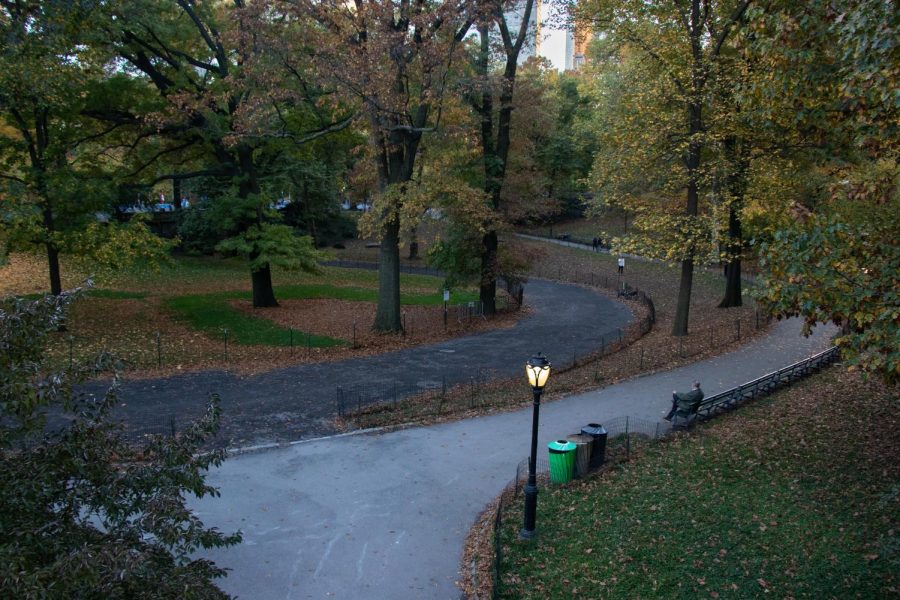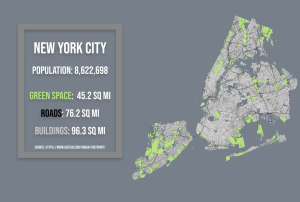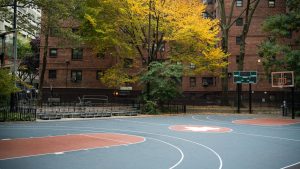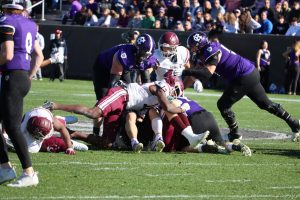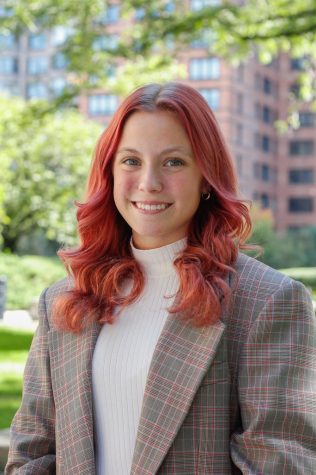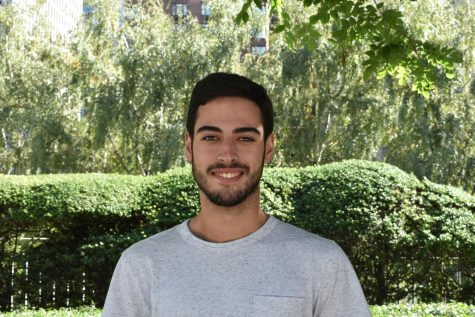Stepping Outside: The Fordham Community and NYC’s Local Green Spaces
Fordham students and faculty weigh in on the diverse possibilities for engaging with New York City naturescapes
The Environmental Club goes to Central Park, Riverside Park, farmers’ market outings around the city, dinner outings at vegan restaurants and also on hikes in upstate New York.
November 6, 2022
When most think of New York City, lush open spaces and greenery are rarely the first things that come to mind. However, the Fordham community is challenging the fixed role many have cast New York in.
The Environmental Club concerns itself with both treasuring and preserving New York green spaces. Their outings are centered around environmental engagement, and members have grown familiar with the city’s green spaces. Another opportunity for students to become involved with New York’s nature is Run Club Lincoln Center (LC). Run Club LC centers around creating community through the sport of running and values the opportunity to have Central Park and other outdoor spaces as their backdrop.
Environmental Club Lincoln Center: A Close Relationship to Green Spaces
The Environmental Club is known for being a prominent voice in advocating for environmental sustainability around campus. The club hosts many environmental outings, such as community service events, hikes, discussions with professionals and trips to farmers’ markets. In doing so, the club members engage with the green spaces around the city quite frequently.
The club frequently goes to Central Park, Riverside Park, farmers’ market outings around the city, dinner outings at vegan restaurants and also on hikes in upstate New York. This semester, they are planning to volunteer at Drew Gardens, go on a plant district outing, go on a rooftop urban garden tour in Brooklyn and visit the Louis Calder Center, Fordham’s biological field station, to do volunteer work in the area and take a tour.
“We try to go visit as many of the green spaces nearby or any environmentally related areas as much as possible,” Kenneth Tang, Gabelli School of Business at Lincoln Center (GSBLC) ’24 and president of the Environmental Club, said.
The Environmental Club highly values the green spaces in and around the city and actively seeks to incorporate as many of them as they can into their meetings and outings. Tang explained that nature is not only central to people’s self care and mindfulness but also to all of the wildlife and animals that inhabit the spots that the club explores. It is beneficial to everyone involved.
“One of the biggest parts about living in the city is there’s just so much pollution. The city really needs subtle breaks from the chaos of this urban setting to appreciate what was here before,” Tang said.
“When you are running on a treadmill and only look at a screen, it becomes harder to keep your eye on the objective, and it becomes harder to listen to yourself.” Nollan Wang, President of Run Club LC and FCLC ’23
While exploring the green spots in the city, the club’s overall goal is to spread awareness about how to live sustainably and the importance of being open to trying and incorporating greener options. Their club meetings and events are great opportunities to become more familiar with the environment and environmentally friendly practices.
“Be willing to challenge your current lifestyle with the possibility of introducing greener options,” Tang said.
Run Club LC: Fostering Community with Nature as The Setting
President of Run Club LC, Nollan Wang, Fordham College at Lincoln Center ’23, shed some light on the club’s mission to bring kinship to the Fordham community.
“Running is one of the most simplistic and accessible sports there is, and that is where the beauty of running lies,” he said. “The ability to bring people together really becomes a factor when people are struggling together and developing together, seeing each other get better.”
The club functions as a place where people of all skill and fitness levels can come together to bond through their semi-suffering and to grow close by improving together.
Club Treasurer Raymond Rico, GSBLC ’25, agreed with this sentiment, adding that “it’s a good way to build bonds with other people.”
In crafting such a community, the importance of location does not go unnoticed. When asked about why Run Club LC solely runs outside, both club leaders made clear the passion and purpose behind that decision. They identified a significant difference in mentality between running on a treadmill and running somewhere like Central Park. The outdoors provide diverse stimulations for the eye, distractions for the mind and different landmarks to use as goals.
“When you are running on a treadmill and only look at a screen, it becomes harder to keep your eye on the objective, and it becomes harder to listen to yourself,” Wang explained. “I find running outside helps people set physical goals.”
As a further advantage, running outside also poses a more diverse variety of challenges to improve a runner’s endurance and pushes different muscle groups to grow. Many runners, including Wang himself, find themselves performing at a higher level and progressing faster when running outdoors. The fundamental difference between the uncontrollable nature of green spaces, as opposed to treadmill running, helps make budding runners adaptable and well-versed across different terrains.
The top green space that Run Club LC uses is Central Park. From a technical standpoint, the park provides a variety of loops, ranging in size, incline and overall intensity. As a space, it seems naturally designed for the inclusivity that Run Club LC values and for that reason is a space they continually utilize.
Central Park is wholly unique for a variety of reasons, both social and tactical. Its significance to runners is felt by all who engage with the space.
Central Park “lends itself very easily to this exercise where you’re pushing yourself really hard one moment, and then you have the gradual slow down on the downhill,” Wang said.
He also explained that this particular trait is beneficial for the new runners that the Run Club takes into consideration. By providing spacing between harder and easier moments, the park’s own geography helps to coach pacing and perseverance while rewarding hard work with moments of reprieve.
The park does not just provide opportunities for new runners to improve; it also provides all members of Run Club LC with the chance to feel like a part of the greater running community. When running in the park, runners are quick to acknowledge one another — a deed of simple kindness which feels absent in the vast majority of New York spaces. When asked about the space, both club leaders were quick to mention a nod of understanding runners in the park will give to one another. Wang described the runners’ nod as a “mutual understanding that makes running all the more fun and all the more accessible.”
Beyond the running community, Run Club LC sees the value that Central Park has to offer for all. With its lush greenery and its transition into fall colors, it provides a visual break from the constant pavement that composes much of New York City. Especially for those students who have grown up in New York or live full time in the city, it truly is a retreat from the concrete.
“I’m a commuter too, so I’m on subways all the time in the concrete jungle. Getting to see grass and trees and flowers is a really nice break from normal life,” Rico said.
Central Park is wholly unique for a variety of reasons, both social and tactical. Its significance to runners is felt by all who engage with the space, and the benefits it can provide are reaped each day by a variety of groups. Run Club LC is a phenomenal example of such a group, which grows with each and every run through the park and each engagement with the New York outdoors.
Fordham Faculty: Relationship Forming with NYC Outdoors
The students are not the only ones who interact with the city’s green spaces: Many professors and faculty members in the Fordham community also utilize them on a regular basis.
“I love the plaza level outside by the ram statue. I like to sit out there and have lunch and hear the traffic below and see the Fordham community walking around,” Christiana Zenner, associate professor of theology and faculty adviser of the Environmental Club, said. “I appreciate how all of these things fit together in a constant motion.”
While embracing the different green areas near and far, Zenner said also enjoys walking around Central Park or having meetings there. Something that struck her when she first moved to the city was how much the presence of particular trees or gardens in little lots or planters on the road mattered to the look of the city. She believes these are important to the urban environment.
“Humans are interdependent with the specific natural and social worlds we inhabit. We need to continue to deepen those relationships in ways that are sustainable over time and for generations with attention to justice,” Zenner said when discussing the importance of green spaces in the city.

